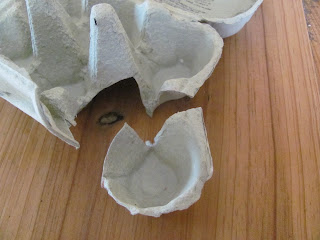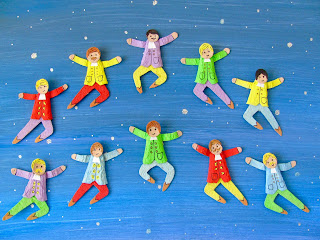Sometimes I know how I'd like a project to look at the end, but am not quite sure how to get there... This was one of those!
We had a few interesting attempts at getting Mel the snail back into his egg carton shell, and this, I think, is the best one.
You will need:
Egg carton
Paint
Sticky tape
Kebab skewer or cocktail stick
Cereal box card (optional)
Green paper (optional)
Glue (optional)
1. The thing about egg carton cups is that on the whole, it's impossible to cut them out neatly with a nice even edge. Usually there will be two big gaps, where the cup joins onto the middle cone (yes, I spend way too much time looking at egg cartons!)
On the LHS you'll see how most egg cups look when you've roughly cut them out, and on the RHS, a nice neat round one, the way you'd like them to look, but they aren't always so easy to find...and that's okay!
2. ...because I'm going to use the one on the left and make the most of its weird, gappy shape.
So, neaten around the top edge and simply cut out the messy joins, right down to the base of the cup.
3. Then paint your shell whatever colour or colours you like.
If you're using a kebab stick, cut or break it in half, snip off the pointy end and paint one end the colour of your snail shell.
4. For the snail's body, cut a strip of plain or coloured paper about 12cm long and roughly 1cm wide. Fold it in half, then place your stick in the crease, with about 1cm of the painted end sticking out.
Get your little crafter to hold the stick steady while you cover the strip of paper with a piece of sticky tape (a bit longer than the paper strip). Start in the middle, so you get it nice and tight around the stick.
5. Snip the sticky tape either side of the stick/skewer, and on both sides of the paper strip (try not to cut through the paper), and carefully fold the sticky tape under the strip.
6. Cut off any extra bits of sticky tape at the ends and then make the tentacles by cutting down the strip (about 3cm), close to the edges on either side - fold the middle part back and snip it off.
The shiny sticky tape gives it a slippery, slidey look, which is perfect for a snail!
7. Now, fold the body in half, and tightly roll it around the stick a few times. When you let go it will unfurl a little.
8. Make a hole in the middle of your egg cup shell (use something like nails scissors - keep them closed to pierce the hole - place some modelling clay under the bottom of the cup, so you have something to push against).
Use a black pen to draw a shell swirl, starting from the hole.
9. Unfurl your snail body, feed it into the grooves, so the head and tentacles are pointing up, and push the end of the skewer stick into the hole.
The tail end needs to be snipped now, as it will be too long. When you're happy with the length, take the body out of the shell again and round off the end of the tail.
10. Make sure both ends are through the gaps, the stick is pushed in as far as it will go, and then twist the stick slowly, either way, and the snail will go back into his shell.
You can simply hold the bottom part of the cup to do this, or blue tack the base of your snail to a table or other hard surface. You will need to take the stick out every time he's gone back into his shell, and thread the body through again, to repeat the action, but this is simple enough to do.
Occasionally wrap the body tightly around the stick again (step 7)
Optional:
11. We made a little cardboard scene for our snail out of a piece of cereal box card.
We painted the top part blue, with splodges of white for the sky. When dry, get some green paper and cut long, spiky zigzags for grass. No need to cut the paper to size at this stage, just make sure you've cut enough grass! Rub glue stick or brush a thin layer of glue on the bottom half of the card.



Either hold the scene in one hand while turning the stick, or blue tack it to a table. You will need to take the stick out to reset your snail. Bend the card back, remove the stick from the shell, unfurl, feed through the gaps, push the stick back in the hole, and you're ready to go again.





















































